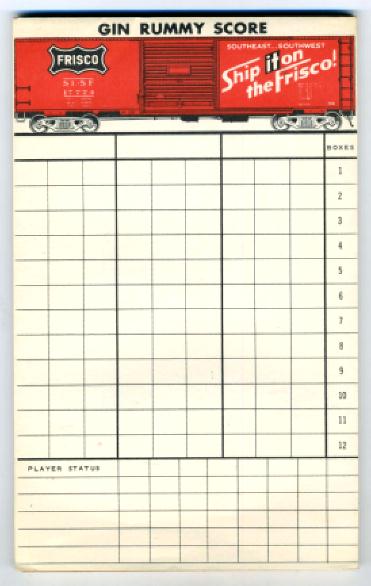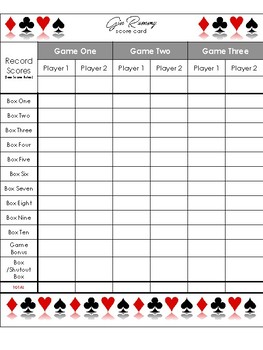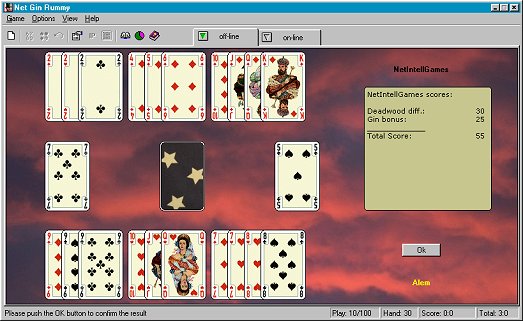Gin Rummy Rules And Scoring
The Basics of Gin Rummy
Running totals are kept with a line under each hand won, and the first player to reach 100 wins the game and scores an additional 100 points. Each player then adds 25 points for every hand won. If one player fails to score, the opponent’s score is doubled (“shut out”). Tips on How to Win Gin Rummy.
-Number of players: two or more;
If you go Gin, you score 25 points, plus the sum of whatever your opponent fails to make into complete combinations — her unconnected cards, or deadwood. You must pick up a card, either from the stock or the discard pile, before you go Gin. To better understand how to score points after you win, take a look at the cards in this figure. See full list on techube.com. Learn how to play rummy including the objective of the game, the rules, scoring combinations and different variations (including the use of wildcards)!
-Playing time: 5 minutes (per hand)
-Cards: standard deck with no joker.
-Ranking: King (high) down to Ace (low). Suits are equal. Court cards count 10 each, Aces count 1 and other cards their pip values.
-Deal: highest cut has option on deal. At this stage only, when cards are equal, suits are ranked in the following order: Spades (high), Hearts, Diamonds, Clubs (low). Each player is dealt 10 cards, singly and alternately, and the remainder of the pack is stacked face down to form the stock pile. The top card is turned over adjacent to it to start the discard pile. The dealer alternates.
History
Gin is probably the best of the two-handed Rummy card games. It was popular in America during the early decades of this century. It then suffered a decline, only to come back briefly to enjoy unprecedented publicity during the 1940s after Hollywood stars adopted it as their favorite game for filling in time between takes.;
Object of the Game
To form one’s hand into melds (sets) and reduce the number and value of unmatched cards.
How to Play Gin Rummy
Elder may now draw a card and take the face-up card from the deck and replace it with a discard from hand. If Elder does not want it, Younger may pick it up and replace it with a discard from hand. If Younger does not want it, Elder now will draw the top card from the stock pile and replaces it with a card from hand face up to the discard pile (which is kept squared up so that the cards below it are not visible). From here on, a player may take either the face-up card from the discard pile or the top card from the stock pile, in both cases surrendering a card from hand to the discard pile.
There are two kinds of meld: a set of three or four cards of the same rank (for example, Jacks); and a sequence (three or more cards of the same suit in order, for example – 7, 8, 9, 10, Jack, all of Diamonds). Notice that A, K, Q of a suit is not a sequence since Ace ranks low.
Either player with unmatched cards (“deadwood”) that total 10 or less may, but is not obliged to, “knock”, thereby ending the hand. Knocking is done physically by rapping the table after drawing a card (but before discarding). The knocker discards and then puts the hand down, face up, divided into melds and deadwood. Provided that the knocker has deadwood the second player may now “lay off” any number of cards from hand to the exposed melds; for example, by adding the fourth Jack to a set of three Jacks. The purpose of laying off is to reduce deadwood which otherwise counts against the player.
Scoring
Gin Rummy Rules And Scoring Rules
When the opponent has laid off, both players declare the total value of their unmatched cards (“the count”). If the knocker’s total is zero – in which case the opponent may not lay off – this is gin and scores 25 for the knocker.
If the opponent’s total is higher, the knocker scores the point difference between the two hands (for instance, if the knocker declares four, and the opponent declares 27, the knocker scores 23). If the opponent’s total is equal to or lower than that of the knocker, the opponent scores the difference, if any, plus 25 for “the undercut”.
Running totals are kept with a line under each hand won, and the first player to reach 100 wins the game and scores an additional 100 points. Each player then adds 25 points for every hand won. If one player fails to score, the opponent’s score is doubled (“shut out”).
Tips on How to Win Gin Rummy


It is imperative to remember every card in the up pile (recall that is squared up so that only the top card is exposed). This will be invaluable in calculating the odds against getting a card you want: there is no point holding on to two Jacks if the other two have been discarded! It is just as important to watch your opponent’s play carefully: every up card is taken or rejected, and each card discarded, tells you something of the composition of his hand.
It is a good principle to knock as early as possible; but if there is a chance of gin it may be better to hold up, since if your opponent knocks you could well score for the undercut. However, do not hold up for more than a turn or two – a gin is only worth double a knock.
A hand can have several embryo melds. Which to keep and for long is a matter of judgment, but should take into account what lies in the discard pile. If you hold two cards of the same rank the chance of getting a third is about the same as of securing a sequence – provided that the pair of cards you hold are capable of being extended at either end. Don’t for example; hang on to King, Queen or 8, 6. A favorable holding would be 4 of Clubs, 4 of Diamond, 3 of Clubs, when you have the advantage of two chances of a sequence and two for a set of 4s coupled with low penalty points if your opponent knocks.
Gin Rummy 500 Rules And Scoring
Hold back any card you think your opponent wants. Apart from the obvious advantage, you may be able to lay it off if you are beaten to the knock. Otherwise, reduce your deadwood at every opportunity – even break up a pair if there is a significant gain. Discard a Queen from a pair, for example, if you pick up a deuce. Finally, if you knock, arrange your hand so as to minimize layoffs.
An Example Hand of Gin Rummy
Elder declines the turn-up. Younger takes it, melds three 7s and discards the 8 of diamonds.
Elder picks up 6 of Clubs and discards it, holding on to the King and Queen for one round. Younger picks up 6 of Diamonds and discards it likewise (it would have been better to have discarded the Queen of Hearts, but Younger is praying for the Jack of Hearts). Elder then picks up 3 of Clubs, making a second meld, and throws out King of Clubs.
Younger picks up 4 of Diamonds and discards Queen of Hearts – it would be dangerous to retain it any longer. Elder picks up 7 of Diamonds and gets rid of the Queen of Clubs; Younger picks up 6 of Hearts and discards the 10 of Hearts in order to reduce deadwood.
Elder picks up Jack of Diamonds and discards it.
Younger joyfully takes it to meld three Jacks and throws away the 9 of Hearts. Elder, joyful in turn, retrieves the 9 of Hearts; melds the 9s; knocks; discards the 7 of Diamonds; and spreads his hand, separating the melds.
Elder
Younger
Elder has a count of one. Younger now spreads his hand and lays off the 6 of Hearts and 2 of Hearts, thereby reducing his deadwood, for a count of nine. Notice that Elder cannot now add the Ace to the heart meld. Elder wins by 8 points and at the end of the game will score a further 25 points for the line.
Variants
A number of variations in scoring may be encountered. A game can be for 150 or 200 points: the gin and box bonuses can score 20 instead of 25, and the undercut can score 10 instead of 20 – or indeed any combination of these and the point values are given above.
A common procedure is for the 21st card to be dealt to Elder who then discards to start the up pile.
A variant which has now largely taken over from the parent game, and is recommended is Oklahoma Gin. There is only one rule change: the turn-up determines the maximum number of points a player may have in deadwood in order to knock. If the turn-up is Ace, some players require gin in order to knock. Gamblers are fond of doubling scores for the hand if the turn-up is a Spade.
Scoring in Gin Rummy

In the United States, the most usual scoring system used in gin rummy is the 20/25 system, though the 10/20 system is more conservative.
10/20 system
If the knocking player goes gin, he gets 20 points, including the deadwood score of the player defending.
On the other hand, if the knocker does not gin, and the defending player has a lesser or similar deadwood count, the knocker is undercut, and gets ten points including the difference of his lower deadwood count.
If the knocker does not gin and is not undercut, he gets a point based on the margin of his lesser deadwood score compared to the defending player.
20/25 system
This is similar to the 10/20 system only the extra point for a gin is 25 points rather than 20, for the undercut bonus, the value is 20 instead of 10.
Single match
In a single match, the round of play proceeds until a player obtains more than one hundred points. That player is the winner of the game.
Multi-match
Monitoring both the match and game scores are very common in multi-match games. Match scores are brought back to zero at the beginning of every match, but the game scores pile up from every match, and determines the winner. The game comes to an end when a player has reached 100 match points.

At the conclusion of the match, players' match scores are added to their game scores as well. � 25 game points are awarded for every round won, � 100 points is awarded to the match winner � 100 bonus points to the winner of the match if no round was won by the loser.
Hollywood Scoring System
It basically enables three games to be played simultaneously. The scoring sheet is split into three groups of two columns. The headings of the columns indicate the initials of the players. When the first hand is won by any player, the score is noted in the initial column. A win in the second hand will be duly noted in the first two columns, and the total for the third hand is reflected on the three columns. When the scores in a certain column tally to the set amount (commonly 125), a cross is placed on the column, and additional scores will be disregarded.
The three games could be played immediately using several piles of cards, or could be played one at a time. Other games may have more than three games, adopting the same rules.



